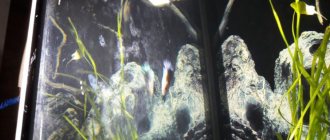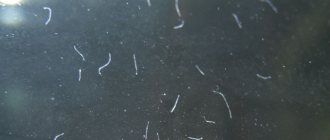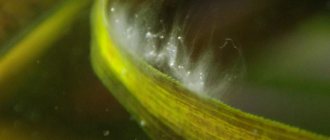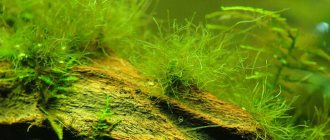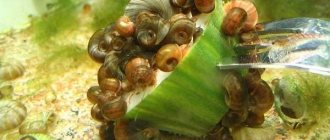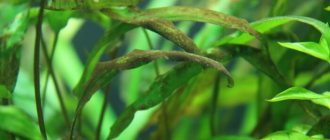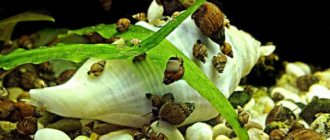Sometimes owners of artificial ponds are faced with such a problem as small white worms in the aquarium. These are nematodes - they appear on the glass of the tank, in the soil, in stones, and spoil the appearance of the tank, giving the artificial reservoir an unkempt appearance. In addition, nematodes in the aquarium are divided into many varieties: individual worms are safe for the life of fish and plants, but there are varieties of white parasites in the aquarium that are harmful and a threat to the inhabitants of the reservoir.
What is a nematode
Aquarium owners know that in an artificial reservoir, each organism occupies an individual niche and is part of the ecosystem. The more diverse and numerous the living creatures in the tank, the more stable the biological balance. A sterile body of water without bacteria, microorganisms and ciliates indicates that the ecological balance is disturbed. However, in addition to beneficial organisms, harmful parasites develop in the reservoir, which threaten the well-being of the inhabitants. Nematodes are classified as roundworms, and look like tiny white worms no more than 2 mm long. To date, scientists have identified over 24,000 varieties. Nematodes in an aquarium do not pose a threat to residents, since they are food for fish. In some cases, these microorganisms are deliberately bred as pet food. Nematodes live in an aquarium for a couple of days, after which they are eaten by fish or eliminated by the owner of the tank.
It is possible to defeat parasites!
Antiparasitic Complex® - Reliable and safe removal of parasites in 21 days!
- The composition includes only natural ingredients;
- Does not cause side effects;
- Absolutely safe;
- Protects the liver, heart, lungs, stomach, skin from parasites;
- Removes waste products of parasites from the body.
- Effectively destroys most types of helminths in 21 days.
There is now a preferential program for free packaging. Read expert opinion.
Read further:
Algae parasites in the aquarium: examples, description and control methods
Demodex on the face: reasons for its appearance, how to get rid of it, the best ointments
Aquarium fish parasites: worms, algae, name and description
Types of roundworms (nematodes): description and general characteristics of parasites
Mesophiles in animals and plants, reproduction temperature
What do worm larvae look like: round and tapeworms, flukes
Types of aquarium worms
Underwater thin worms grow in the soil, decorations, glass and are divided into two types: aquarium parasites and worms that do not pose a threat. It’s easy to escape from harmless worms, but with parasites the situation is more complicated: nasty pests adapt to any conditions and lead to the death of your beloved pets. To figure out what type appears in the tank, you need to consider the common varieties:
- Planaria in an aquarium are serious pests that pose a threat to all inhabitants of the tank. Worms live in the ground, at the bottom of the container, and become noticeable in two cases: when the number has grown to colossal proportions, or if changes in water parameters have occurred. A distinctive feature of planarians is their triangular head.
- Turbellaria - refers to ciliated worms, and have a flat body surrounded by cilia. Flatworms can appear suddenly, most often on the glass of the tank or near the filter, but can settle on rocks and plants. Turbellaria are harmless to adult fish, but they pose a danger to eggs, mollusks and fry.
- Nematodes are thin worms in the aquarium that have a lifespan of a couple of days. Nematodes are food for phenotypes and are harmless, but in large numbers they spoil the appearance of the tank and the purity of the water.
- Hydras - for most aquarium inhabitants, hydras are harmless, but in rare cases this species can attack fry or eggs. It should be noted that hydras are incredibly tenacious.
To accurately determine the type of worm, experienced aquarists perform a simple trick: raise the water temperature by 2 degrees and increase the salinity. These actions will not harm pets and plants, but will bring death to nematodes. If the worms in the aquarium did not die, then another species appeared in the tank.
Causes of appearances
White worms may appear in an aquarium even if it has been recently started and previously disinfected. However, most often nematodes are observed in old and dirty artificial reservoirs. The causes of parasite development are:
- irregular cleaning - worms multiply in organic deposits and uneaten food residues;
- introduction of helminth eggs with decorations, plants, soil and live food, especially collected in natural reservoirs;
- adding new inhabitants to the aquarium - infected fish and snails.
A favorable environment for the reproduction of helminths is glass and decorations overgrown with algae. The abundance of organic matter in the water, silty soil, combined with poor filtration and low environmental temperatures contribute to the rapid development of parasites.
How to get rid of worms in an aquarium
White worms on the walls of the aquarium cause a lot of inconvenience to owners: they disfigure the appearance of the reservoir, and in some cases lead to the death of fish and plants. Before you learn how to get rid of worms, you need to determine the type of pest. As mentioned above, nematodes in an aquarium are detected by increasing salinity and temperature by two degrees. These conditions will destroy the nematodes, but to be completely sure, you can stock the tank with labyrinthine fish, for example, gouramis, which will happily feast on the worms.
If after the measures taken the worms do not disappear, it means that the pond has been chosen by parasites. Control pests in the tank as follows:
- To destroy planaria, traps are used - the meat is wrapped in a piece of gauze and left overnight. In the morning, the trap with parasites is thrown out. This method will destroy only part of the planaria, and drugs containing fenbendazole are used against the remaining pests.
- Turbellaria is removed mechanically by scraping worms from glass. Then the living creatures are moved to another container, and the temperature in the affected tank is raised to 35-40C. This temperature regime is maintained for two hours, after which, having returned the water parameters suitable for fish, the pets are reintroduced.
- Hydras in the tank are removed by restarting the aquarium with a complete change of water and decorations. Additionally, the reservoir is stocked with gourami, snails and molly, which will happily feast on hydras.
Nematodes in an aquarium are harmless worms that serve as food for phenotypes. You can get rid of worms by raising the salt content and temperature of the water environment by a couple of degrees, or by seeking help from specialists who will select the right weapon to exterminate uninvited guests.
Prevention
A number of simple measures will eliminate the need to fight worms.
Every 7 days it is necessary to clean the aquarium and partially change the water. Before using stones and decorations, they are thoroughly disinfected. The stones are cleaned of moss and dirt and calcined in the oven.
The decor is also washed with warm water and, if the material allows, left in a pink solution of potassium permanganate for a day, after which it is rinsed and allowed to dry. Soil and sand can also be kept in the oven.
If you cannot do without live food, then it is better to buy it in stores rather than get it yourself. You need to be especially careful when feeding fish with tubifex, insect larvae, and copepods.
What is the danger of planaria
By their feeding method, these flatworms are predators. They do not penetrate fish and crustaceans like parasitic worms; their danger lies elsewhere. A good appetite and high activity makes them eat caviar
– especially snails and shrimp. However, fish eggs of small species also suffer from planaria.
Adult animals are also not immune to the harm that these pests can cause. By getting into the gills of fish, planaria cause discomfort to the latter, and if there are too many of them, they can lead to suffocation.
The appearance of these flatworms in shrimp tanks and other aquariums where crustaceans are present is especially undesirable. The fact is that during molting, planaria penetrate into the space between the lagging old shell and the new, still tender surface. Sometimes this can lead to the death of shrimp, especially small ones.
Not all aquarists are unanimous in assessing the danger of planaria for shrimp keepers. Planarians not only hunt, but also eat carrion. In a “bank” with poor care, where shrimp often die and dead specimens are not removed in a timely manner, planaria are intensively bred due to the large amount of food. The owner thinks that it is the presence of worms that is the reason for the “death” of shrimp, that is, it reverses cause and effect. One way or another, planarians pose almost no danger to large adult individuals.
The situation with caviar is much worse. The worms, grown up to 2 centimeters, greedily eat it and also attack newly hatched shrimp. They can also attack adult snails.
Reproduction
The white planaria has female reproductive organs and male reproductive organs, so the worms reproduce asexually or sexually. Reproduction usually occurs sexually. Two individuals swim up to each other, stick together for a couple of seconds, during which testes are transferred from one worm to another. Fertilized cells enter the oviduct, become covered with a hard shell, turning into eggs. Worms lay eggs on plants. After two to three weeks, new worms emerge from the eggs.
Shelly crustaceans
Ostracoda barnacles are bean-shaped crustaceans that reach a length of 4 mm. Sometimes you can see them scurrying around on the substrate, like tiny moving specks. These creatures are yellowish or black-brown in color. They attach their eggs to plants, so they can be accidentally introduced into the aquarium along with plants, as well as live food. They are found in small numbers in aquariums, but if aquarium hygiene leaves much to be desired, they can begin to multiply rapidly and become a real disaster. Thus, although barnacles are harmless, their presence indicates an environmental or nutritional problem with the fish. These problems can have adverse effects on fish. Improving aquarium care is a solution to both problems at the same time. It allows you to control the number of these animals and eliminate the causes of their rapid reproduction.
Nematodes as food: breeding and growing methods
Nematodes are a favorite treat for many aquarium fish. In order to breed and raise worms for food, they use various containers with a shape similar to wide, shallow plates. The procedure does not cause any difficulties and is carried out as follows:
- The bottom of the container is lined with food (layer thickness - 15–20 mm).
- Place a piece of the old culture on the layer of food (if you have already grown this type of biofeed before) or a starter culture purchased at a pet store.
- Glass with a piece of foam rubber glued inside is placed on the container, which must be periodically moistened (if the container is hermetically sealed, foam rubber is not needed).
The following foods are used as a nutrient medium for breeding roundworms:
- porridge based on oats, barley or oatmeal flour, with a small amount of milk;
- oatmeal flour with grated carrots, scalded with boiling water, with the addition of multivitamins;
- thick oatmeal;
- bread soaked in milk;
- white bread (without crust), poured boiling water, squeezed out and cooled;
- finely grated carrots, brewed with boiling water (the root vegetable processed in this way can be added to other types of food);
- thick curdled milk.
Important! All feed for breeding nematodes should have the consistency of thick porridge. In a liquid environment, the larvae may die. The cultivator is installed in a dark place with an air temperature of +22…+28 °C. After 48–96 hours, the roundworms will begin to actively reproduce.
To collect biofeed, a smooth object (domino, piece of plastic, etc.) is placed on the nutrient medium, which will soon be covered with young worms. Harvesting is carried out using a brush, which after the procedure should be rinsed in a container with clean water. When the nematodes settle to the bottom, the cloudy water is drained. Do this several times until the water becomes clear.
It may happen that the worms themselves try to crawl out of the cultivator along the walls, in which case it is enough to collect them with a brush and rinse the brush in the aquarium.
In the aquatic environment, nematodes live for approximately 48 hours. Since the worms settle on the ground, the water should be stirred up periodically; some fry will not eat food lying on the bottom.
Not all fish eat nematodes, but vinegar eels mixed with carrots are happily consumed by any fish. The grated carrots are placed in a cultivator, and the crop is laid on top of it. In such an environment, fairly rapid reproduction occurs and a carrot-colored nematode appears, which fish readily eat.
Video: Breeding nematodes at home If, when breeding roundworms, you notice an unpleasant odor or the nutrient medium begins to change color, change the container and start the culture again. If the nutrient medium becomes too liquid, add oatmeal to it until the desired consistency is obtained.
Did you know? The nematode Halicephalobus mephisto lives in the earth's crust at such a depth that no other multicellular creature living on our planet descends.
How to recognize a planaria
Planaria are classified as flatworms, which means they are the most primitive representatives of the type.
This determines their extremely high adaptability and survival. And although zoologists are delighted with the peculiarities of these organisms, for an aquarist it is a real headache, because sometimes the only way to get rid of pests is a complete restart with disinfection of all components and quarantine for living creatures. Planaria have sizes from 2 mm to 3 cm. The body is elongated and flattened in the dorso-ventral direction. The head has a clearly defined diamond or triangular shape, and upon close examination, one can distinguish two large black eyes, with the help of which the worms distinguish light from darkness.
They settle in secluded places - under stones, in grottoes, in the root systems of plants. The peak of activity occurs at night. However, even during the day, planaria often crawl onto stones, glass, plant leaves, or even rise to the surface of the water. Sometimes they swim with the help of small cilia covering the entire surface of the body.
In its normal state, the planaria is whitish-translucent, but its body is colored depending on what it eats.
Copepods
Copepods are small aquatic crustaceans. Most of them are harmless to fish. Some free-living species, such as Cyclops, are used as live food. At the same time, representatives of some species of copepods are parasitic on fish.
Cyclops - used as live food
Free-living, harmless copepods are usually translucent and reach a length of 3 mm. They move in short leaps, but can also lie on underwater surfaces, including on the glass of an aquarium, where they are introduced either intentionally (as live food) or accidentally (on plants). Few manage to survive in an aquarium for a long time - for most fish this is a real delicacy. True, large fish do not pay attention to them - after all, they are too small and should not be eaten. Thus, contamination of an aquarium with free-living copepods can only occur if the fish do not eat them - either because they are unsuitable food, or because the fish are so unwell that they have lost interest in even such a tempting food source . This may be due to environmental pollution (heavy organic load). If copepods begin to reproduce in the aquarium, it means there is organic pollution.
If you eliminate the problem that caused this behavior of the fish, then the fish will solve it themselves with great pleasure.
Worms in aquarium fish: symptoms and treatment
› Infection
09.01.2020
The angelfish is considered the most popular variety of aquarium fish. A distinctive feature of which is good health and interesting territorial behavior.
If unfavorable conditions are created, the fish may be susceptible to infectious or foodborne diseases, and if treatment measures are not taken in a timely manner, the fish may die. Diseases of angelfish are either contagious and transmitted to other inhabitants of the underwater world, or not.
Often the cause of the disease lies in the provision of poor quality care, as well as the introduction of new inhabitants and plants into the aquarium without prior quarantine.
Serious harm is caused to angelfish by parasites that can get in with live food (bloodworms, tubifex, daphnia, brine shrimp). Some parasites can be introduced with new inhabitants who were infected at the time of purchase. As a rule, external signs do not appear for a long period of time, as a result of which it is impossible to immediately recognize a sick fish.
If an animal is affected by worms, then you can find out about it only after their development has reached its maximum limit. You can understand that a fish is dying by a number of signs:
- The angelfish practically does not move around the aquarium.
- Lost appetite.
- Breathes frequently.
- The fish does not respond to stimuli.
- In appearance, severe exhaustion associated with malnutrition becomes noticeable.
- Waste products change color dramatically.
- The fish always lies on the bottom.
- There may be bloating in the abdomen, small wounds all over the body (some worms that have reached maximum development begin to leave the body, leaving behind wounds).
If it becomes clear that the fish has the last symptom, then it will not be possible to save the individual. As a rule, such fish die within a few hours or days.
With other symptoms, the animal can be saved. To do this, you will need to purchase anthelmintic drugs intended for fish at any pet store. In most cases, the drug is added to the general aquarium.
If a sick fish is found in a community aquarium, then all inhabitants must be treated.
Microspores
Infection by microspores can be recognized quite easily by the following signs:
- Black spots are visible all over the body.
- The angelfish completely loses its appetite.
- The fish move little and sink to the bottom.
It is important to understand that this disease cannot be cured , so every effort must be made to prevent infection of other inhabitants of the aquarium.
A sick individual should be immediately transplanted separately or killed. The aquarium is cleaned, the water is changed, the equipment is washed, and then methylene blue is added for preventive purposes.
For 2 weeks, feeding is as nutritious as possible; it is best to use live food. In order to prevent this from happening in the future, it is recommended to use high quality food from well-known manufacturers. Clean the bottom and change water by 10-20% daily.
Protozoa
Most often, the body of the angelfish is affected by protozoa, which in turn can cause a number of diseases. The following symptoms will make it much easier to recognize the presence of this type of infection:
- The lateral line is deformed.
- Waste products change their color to white.
- The feces are thin, resembling white thin threads, and they are quite long.
If the condition is satisfactory, it is quite possible to save the animal; to do this, it is enough to select special preparations at the pet store. In severe cases, death is inevitable.
Attention! All fish that were with an infected individual must be treated for preventive purposes.
Bacteria are another common type of infectious disease. As a rule, pathogenic microorganisms are always present in the aquarium, but when their number exceeds all permissible standards, this negatively affects the health of the aquarium inhabitants. In most cases, tuberculosis and fin rot occur.
Fin rot
Fin rot is a common type of disease affecting fish. Individuals with veil fins are most often affected. If the outbreak is severe enough, the infection can spread to ordinary fish.
Fin rot can be recognized by a number of signs:
- Cloudy eyes and fins.
- The edges of the fins do not have a clear line, they become uneven.
- The fin on the back is torn.
If it is noticed that the fins have begun to tear, then it is worth taking immediate measures to treat the animals, otherwise the infection will begin to progress. If rotting moves from the fins to the body, then you can forget about saving the angelfish.
Tuberculosis
Tuberculosis cannot be cured; the infected individual dies. The sick fish must be destroyed ; the remaining inhabitants of the underwater world are fed live food for 2 weeks. In addition, you will need to change the water and boil the soil.
- You can see clouded and bulging eyes.
- The original body color becomes dull.
- The fish is severely emaciated, its stomach collapses, and its spine is bent.
- A sick angelfish constantly hides in shelters or in thickets of plants.
The animal dies in the shelter found, after which it begins to decompose and spread pathogens of a terrible infectious disease.
Pseudomonas aeruginosa
This type of disease is bacterial; the fish begins to experience internal hemorrhage.
You can see ulcers on the sides, which is the only sign by which an infected individual can be recognized.
For treatment, antibiotics are used, which can be purchased at a specialty store. Unfortunately, it is not always possible to cure animals. The population or some part of it dies.
Viruses and fungus
The proliferation of fungal and viral diseases occurs mainly in conditions of severe pollution of aquarium water.
If we consider the most common fungal and viral diseases, we can highlight the following:
It is the most dangerous disease for which it is impossible to cure. As a rule, almost all fish die. A white rash appears on the body. The angelfish swims on its side, coordination suffers greatly. The sick individual must be immediately destroyed, and the aquarium must be treated (the water is drained, the soil is boiled);
Dermatomycosis
The causative agent of the infection is a mold fungus, as a result of which a white coating appears on the body of the fish, and the eyes may become cloudy. The most important thing is to start the treatment process in time, when the damage to the scales has just begun, otherwise the fungus will begin to penetrate inside. “Streptocide” must be added to the aquarium. Baths with added salt will not hurt;
Ichthyosporidiosis
The internal organs of the individual are affected, so it is impossible to immediately determine the disease. In infected animals, the scales begin to darken, the eyes bulge, and the angelfish does not eat.
If the infection has reached the nervous system, then the fish loses coordination, it swims upside down, moves in leaps and bounds, after which it sinks to the bottom of the aquarium and lies on its side.
Fruitful treatment is only possible if the disease is detected early;
A fairly acute and contagious viral infection that spreads very quickly in an aquarium. Red spots and inflamed red gills appear on the abdomen. Unfortunately, there are no treatment recommendations and, as a rule, the individual dies.
In order to prevent the occurrence of many diseases, it is recommended to provide angelfish with favorable living conditions.
Hexamitosis
Hexamitosis is a parasitic disease found in aquarium fish that affects the intestines and gall bladder, resulting in severely damaged appearance. Holes, open wounds, and ulcers appear on the body. This disease has several names - hexa, octomitosis, hole, spironucleosis. Other symptoms:
- Loss of appetite is the first sign of the disease. Quite often you can notice that the angelfish spits out food without even swallowing it. If measures are not taken in a timely manner, the animal will completely lose interest in food. Many aquarists classify this behavior as fish selectivity, however, this is not always the case.
- Thread-like white discharge is another symptom. Since the individual’s body is affected, the epithelium begins to stand out and come out of the fish in large quantities, which becomes noticeable. Often you can see discharge with undigested food - this is a signal of intestinal damage.
- The fish swims at the surface of the water, stays apart from its relatives, and the color of its scales becomes much darker.
- In addition, the sick fish loses a lot of weight, the stomach changes its original shape - it becomes concave, the back is deformed. In some cases, abdominal bloating is observed.
Very rarely, sufficiently deep holes appear on the body from which fluid comes out. Many fish have lateral lines, which in normal conditions are almost invisible. During the course of the disease, these lines become clear and painted in bright shades. Ulcers can run along the entire body up to the head.
